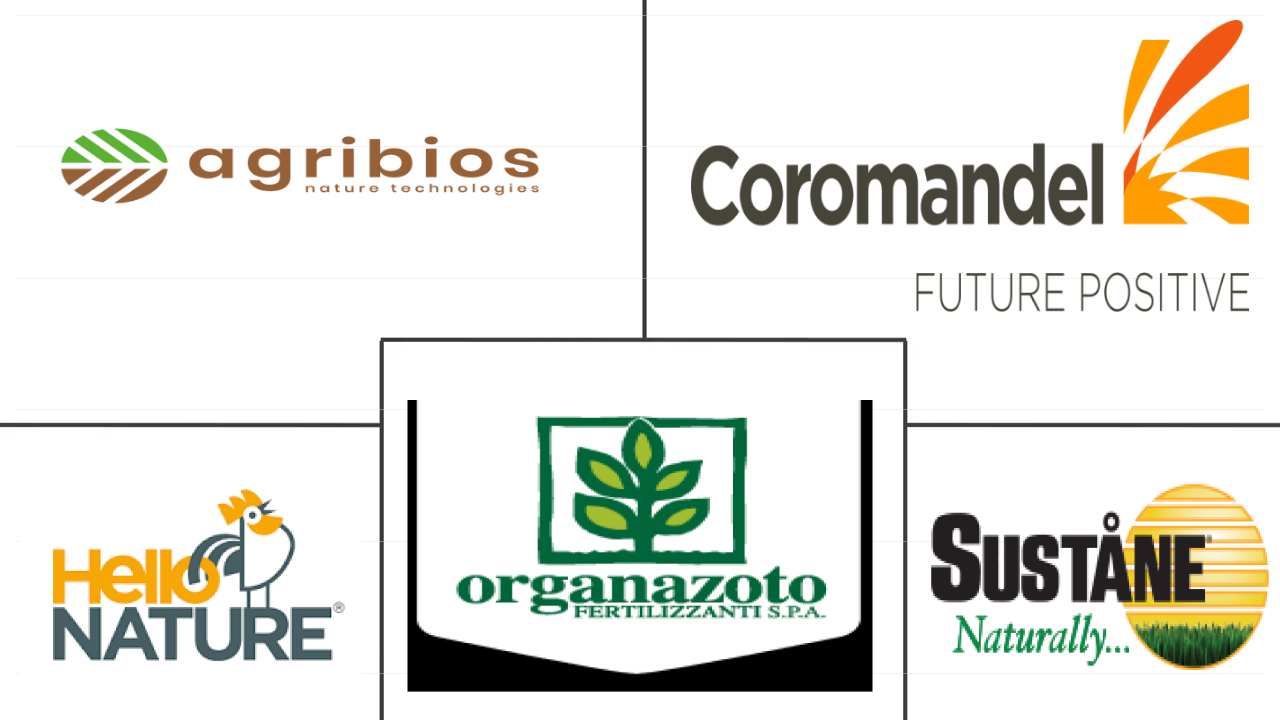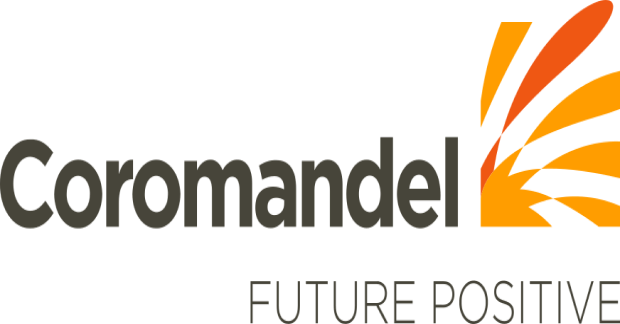Market Size of europe organic fertilizer Industry
|
|
Study Period | 2017 - 2029 |
|
|
Market Size (2024) | USD 4.2 Billion |
|
|
Market Size (2029) | USD 6.14 Billion |
|
|
Largest Share by Form | Meal Based Fertilizers |
|
|
CAGR (2024 - 2029) | 7.87 % |
|
|
Largest Share by Country | France |
Major Players |
||

|
||
|
*Disclaimer: Major Players sorted in no particular order |
Europe Organic Fertilizer Market Analysis
The Europe Organic Fertilizer Market size is estimated at 4.2 billion USD in 2024, and is expected to reach 6.14 billion USD by 2029, growing at a CAGR of 7.87% during the forecast period (2024-2029).
4.2 Billion
Market Size in 2024 (USD)
6.14 Billion
Market Size in 2029 (USD)
4.83 %
CAGR (2017-2023)
7.87 %
CAGR (2024-2029)
Largest by Form
61.89 %
value share, Meal Based Fertilizers, 2023
Meal-based fertilizers are by-products of the meat processing industry that are increasingly being used in Europe, are rich in nitrogen, phosphorus, potassium, and calcium.
Fastest by Form
8.39 %
Projected CAGR, Manure, 2024-2029
Manure is an inexpensive organic fertilizer, provides nutrients for soil life, increases biological activity, and diversity and rich in nitrogen, phosphorus, and potassium.
Largest by Crop Type
77.71 %
value share, Row Crops, 2023
The major row crops produce include Barley, corn, wheat, rapeseed, rye, sunflower, soybean, rice, etc. Meal Based Fertilizers most consumed in row crops with 62.3% in 2022.
Largest by Country
11.51 %
value share, France, 2023
France is the largest market in the European Region for organic fertilizers. Manure is the most consumed organic fertilizers in the country, accounting for 74.1% in 2022.
Leading Market Player
0.78 %
market share, Coromandel International Ltd., 2022

The company manufactures animal manures and biostimulants that are suitable for all types of growing needs such as home gardens, lawns, and commercial crop cultivations.
- The European organic fertilizers market in 2022 was primarily dominated by meal-based fertilizers, which accounted for 62.0% of the market. These fertilizers are highly beneficial to agricultural crops as they are rich in nitrogen, phosphorus, potassium, and calcium. Organic fertilizers based on meat and bone meal help reduce the demand for mineral fertilizers and provide an eco-friendly solution for disposing of large amounts of meat processing waste. Manures also contributed significantly to the European organic fertilizers market, registering a share of 38.3% in 2022. The segment's market value recorded an increase of 58.2% between 2017 and 2022.
- Row crops accounted for a significant portion of the organic fertilizer consumption in 2022 in Europe, with a share of 77.7%, followed by horticultural crops. This can be attributed to the large cultivation area of row crops in the region, which amounted to 82.3% of the total organic crop cultivation area in 2022.
- The development of a low-carbon economy is a primary goal of the EU's growth strategy, and organic fertilizers have the potential to make a significant contribution to this effort. Organic fertilizers help transfer atmospheric carbon dioxide into the soil, which prevents it from being released back into the atmosphere due to their high organic matter content. This approach is expected to drive the European organic fertilizers market, which is estimated to register a CAGR of 7.8% between 2023 and 2029.
- The European organic fertilizer market in 2022 was dominated by meal-based fertilizers and manures, with row crops being the primary consumers. As the European Union continues to push for a low-carbon economy, the demand for organic fertilizers is expected to increase, driving growth in the market.
- Europe has emerged as one of the major producers of organic crops, with 420,000 organic producers as of 2020. In 2022, Europe accounted for 41.7% of the global organic fertilizer market, a testament to the region's dominance in this field. The region's primary crops include wheat, maize, rye, barley, sugar beet, and potatoes, with row crops accounting for the majority of organic fertilizer consumption.
- Europe's organic agricultural acreage has been increasing steadily, with a growth rate of 7.1% from 4.9 million hectares in 2017 to 6.9 million hectares in 2022. This is largely due to the European Commission's objective of increasing the share of organic agriculture to a minimum of 25.0% of the EU's agricultural land by 2030.
- The European Union (EU) is currently revising its fertilizer Regulation for the first time since 2003, aiming to make it easier for new fertilizing products, particularly those containing nutrients or organic matter recycled from biowaste or other secondary raw materials, to enter the market. The new regulation will also establish safety and quality standards for fertilizing products sold in all EU countries. Organic-based fertilizers, with their circular and resource-efficient nature, are precisely the type of fertilizing products targeted by the new regulation.
- Europe's significant presence in the global organic fertilizers market, combined with the region's commitment to increasing the share of organic agriculture, presents a promising future for the organic fertilizers market in Europe. With the upcoming revision of the Fertilizer Regulation, the industry is expected to witness a surge in innovation and growth, providing opportunities for various stakeholders to expand their businesses.
Europe Organic Fertilizer Industry Segmentation
Manure, Meal Based Fertilizers, Oilcakes are covered as segments by Form. Cash Crops, Horticultural Crops, Row Crops are covered as segments by Crop Type. France, Germany, Italy, Netherlands, Russia, Spain, Turkey, United Kingdom are covered as segments by Country.
- The European organic fertilizers market in 2022 was primarily dominated by meal-based fertilizers, which accounted for 62.0% of the market. These fertilizers are highly beneficial to agricultural crops as they are rich in nitrogen, phosphorus, potassium, and calcium. Organic fertilizers based on meat and bone meal help reduce the demand for mineral fertilizers and provide an eco-friendly solution for disposing of large amounts of meat processing waste. Manures also contributed significantly to the European organic fertilizers market, registering a share of 38.3% in 2022. The segment's market value recorded an increase of 58.2% between 2017 and 2022.
- Row crops accounted for a significant portion of the organic fertilizer consumption in 2022 in Europe, with a share of 77.7%, followed by horticultural crops. This can be attributed to the large cultivation area of row crops in the region, which amounted to 82.3% of the total organic crop cultivation area in 2022.
- The development of a low-carbon economy is a primary goal of the EU's growth strategy, and organic fertilizers have the potential to make a significant contribution to this effort. Organic fertilizers help transfer atmospheric carbon dioxide into the soil, which prevents it from being released back into the atmosphere due to their high organic matter content. This approach is expected to drive the European organic fertilizers market, which is estimated to register a CAGR of 7.8% between 2023 and 2029.
- The European organic fertilizer market in 2022 was dominated by meal-based fertilizers and manures, with row crops being the primary consumers. As the European Union continues to push for a low-carbon economy, the demand for organic fertilizers is expected to increase, driving growth in the market.
| Form | |
| Manure | |
| Meal Based Fertilizers | |
| Oilcakes | |
| Other Organic Fertilizers |
| Crop Type | |
| Cash Crops | |
| Horticultural Crops | |
| Row Crops |
| Country | |
| France | |
| Germany | |
| Italy | |
| Netherlands | |
| Russia | |
| Spain | |
| Turkey | |
| United Kingdom | |
| Rest of Europe |
Europe Organic Fertilizer Market Size Summary
The European organic fertilizer market is experiencing significant growth, driven by the increasing demand for eco-friendly agricultural solutions and the region's commitment to sustainable farming practices. The market is primarily dominated by meal-based fertilizers and manures, which are essential for enriching soil nutrients and supporting crop growth. Row crops, such as wheat and maize, are the main consumers of organic fertilizers, reflecting the large cultivation areas dedicated to these crops in Europe. The European Union's focus on developing a low-carbon economy and its ambitious goals for organic agriculture are key factors propelling the market forward. The upcoming revision of the Fertilizer Regulation is expected to further stimulate innovation and growth in the sector, as it aims to facilitate the entry of new organic-based products into the market.
Europe's position as a leading producer of organic crops and its substantial share of the global organic fertilizer market underscore the region's dominance in this industry. The increasing organic agricultural acreage, supported by the European Commission's initiatives, is contributing to the expansion of the organic fertilizers market. Consumers in Europe are increasingly opting for products made from natural materials, with organic food consumption rising steadily. This trend is reflected in the growing organic food markets in countries like Germany and France, which are among the largest in the region. The fragmented nature of the market, with key players like Agribios Italiana s.r.l. and Coromandel International Ltd., indicates a competitive landscape where companies are continually seeking to enhance their product offerings and capture a larger market share.
Europe Organic Fertilizer Market Size - Table of Contents
-
1. MARKET SEGMENTATION (includes market size in Value in USD and Volume, Forecasts up to 2029 and analysis of growth prospects)
-
1.1 Form
-
1.1.1 Manure
-
1.1.2 Meal Based Fertilizers
-
1.1.3 Oilcakes
-
1.1.4 Other Organic Fertilizers
-
-
1.2 Crop Type
-
1.2.1 Cash Crops
-
1.2.2 Horticultural Crops
-
1.2.3 Row Crops
-
-
1.3 Country
-
1.3.1 France
-
1.3.2 Germany
-
1.3.3 Italy
-
1.3.4 Netherlands
-
1.3.5 Russia
-
1.3.6 Spain
-
1.3.7 Turkey
-
1.3.8 United Kingdom
-
1.3.9 Rest of Europe
-
-
Europe Organic Fertilizer Market Size FAQs
How big is the Europe Organic Fertilizer Market?
The Europe Organic Fertilizer Market size is expected to reach USD 4.20 billion in 2024 and grow at a CAGR of 7.87% to reach USD 6.14 billion by 2029.
What is the current Europe Organic Fertilizer Market size?
In 2024, the Europe Organic Fertilizer Market size is expected to reach USD 4.20 billion.

